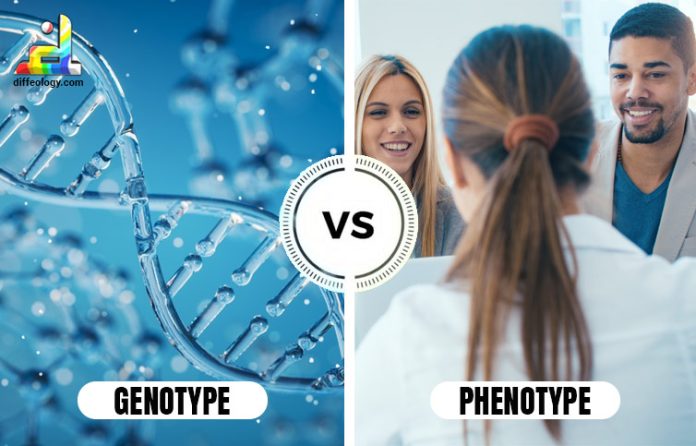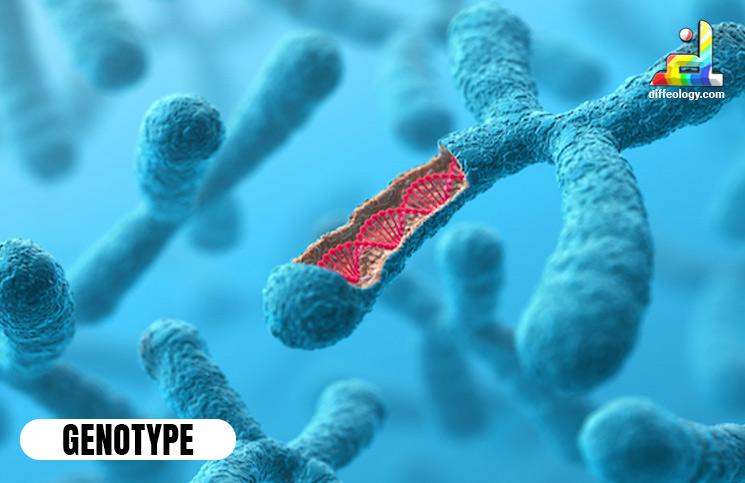It is vital to comprehend the core of genotype and phenotype in cracking a mystery attached to genetic compositions. However, genotype and phenotype are related concepts in terms of what they encompass. There is a huge Difference Between Genotype and Phenotype. First of all, the genotype can be defined as a genetic template carrying information inscribed into an organism’s DNA. Alternatively, the phenotype refers to the visible traits, that is, physical appearance and behaviors emerging from a combination of genetics with environmental forces. Therefore, exploring these concepts sheds light on the complexities of genetics and leads us to understand how genes are transmitted and expressed but also influenced by nature and nurture’s duo.
The Main Difference Between Genotype and Phenotype
The genotype is the genetic constitution of an organism. Phenotype refers to the distinct characteristics of an organism. Genotype is mainly genetically driven. The phenotype is influenced both genetically and environmentally. Within the DNA sequences in each chromosome is a genotype. Phenotype appears outwards in physical form and behavior.
Genotype Vs. Phenotype
What is Genotype?
Genotype is a term used to describe the genetic makeup of an organism. It acts like its biological template. It includes all the genes in an individual’s DNA. These genes are the genetic factors that are transferred from parent to child during copulation. Each gene encodes instructions for either protein production or cellular regulation, ultimately dictating the range of characteristics a given organism can display.
Read Also: Difference Between Homozygous and Heterozygous
Genotype specificity, that is, a combination of alleles inherited from parents, also contributes to the uniqueness. This genetic material is critical to the construction of an organism’s development, growth, and culminating biology. The genotype is the underlying genetic code, while it is an interaction between this coding and environmental factors that determine phenotypic traits such as observable behavioral characteristics & physical features of a particular organism.
What is Phenotype?
This term describes the observable and measurable characteristics displayed by an organism from outside, with genotype being a reflection of its genetic makeup under environmental influences. These attributes include physical features, including eye color, height, and talk type. It also includes behavioral characteristics like temperament abilities. The phenotype is a manifestation of the expression in the genotype. It serves as a genetic program controlling an organism’s development and functioning.
Read Also: Difference Between Cytosol and Cytoplasm
In contrast to the “hidden” nature of a genotype, the phenotype is what we can observe and investigate in humans. It is a representation of the relationship between an organism’s genetic makeup transmitted through inheritance and the multitude of environmental factors it interacts with throughout its lifetime. This phenomenon makes each individual unique since even organisms that share the same genotype can be phenotypically different due to varying conditions and or experiences. Phenotype understanding is critical for solving the difficult question of how genetic traits manifest themselves in an individual’s observable characteristics and behaviors.
Comparison Table “Genotype Vs. Phenotype”
| Definition | Genetic makeup of an organism. | Observable traits and characteristics. |
| Location | Found within DNA sequences in chromosomes. | Manifests externally in physical appearance. |
| Nature vs. Nurture | Primarily influenced by genetics. | Shaped by both genetic and environmental factors. |
| Inheritance | Inherited from parents, determining genetic potential. | Reflects gene expression and environmental influences. |
| Observable vs. Concealed | Hidden within cellular structures. | Observable traits that can be measured. |
| Stability and Change | Relatively stable throughout an individual’s life. | Subject to changes influenced by the environment. |
| Control Mechanism | Genetic information control resides in DNA. | Influenced by genetic and environmental interactions. |
| Precision and Complexity | Provides a precise genetic blueprint. | Represents a complex manifestation of genes and environment. |
| Variability | Contributes to heritability, exhibiting genetic variations. | Displays variability due to environmental factors. |
| Flexibility | Changes occur over evolutionary timescales. | It can be dynamic and responsive to environmental influences throughout life. |
| Control Over Traits | Determines potential traits an organism can possess. | Exhibits directly visible and measurable traits. |
| Mutations and Recessive Traits | It may contain mutations and recessive variations. | Expresses traits influenced by both dominant and recessive alleles. |
| Study Focus | Studied at the molecular level, focusing on genes and DNA. | Studied at the organismal level, examining outward traits and behaviors. |
Difference Between Genotype and Phenotype in Detail
1. Definition and Basis:
The genotype concerns the genetic constitution of an organism. It includes all genes present in its DNA. Genes are the pieces of heredity that carry information for a specific feature, and an individual’s genotype is determined by alleles inherited by both parents. This genetic information is the blueprint for how organisms will grow and operate.
In contrast, the phenotype describes characteristics or traits that are observable and measurable. It is due to the phenotypic manifestation of genes in a genotype, as well as environmental factors. Phenotypes are physical features that include eye color, height, and hair type, while physiological attributes like metabolic rate or behavior can also be included here. Unlike genotype, which is the actual genetic code itself, phenotype characterizes that guiding structure in terms of what it looks like and how an organism behaves.
2. Nature vs. Nurture:
The genotype is mainly influenced by the genes inherited from the ancestors of an individual. It encapsulates the fundamental capacity that all organisms possess and allows them to develop a wide spectrum of traits and behaviors. Although genes serve a crucial function in determining the genotype, environmental factors that interact with development can also influence gene expression and contribute to differences present within the genotype.
Instead, the phenotype is caused by an interaction between genetic and non-genetic factors. Fundamentally, genes provide the beginning but remain modifiable through phenotype due to factors such as diet intake and sun exposure. This nature of the interaction between genetics and environment underlines that the phenotype is not entirely controlled by genetic factors but through which an organism develops in her surroundings.
3. Concealed vs. Observable:
The genotype is hidden inside the cellular structures, especially in the DNA sequences within chromosomes. It is the genetic potential that may or may not be realized in an observable organism. Genes in the genotype can have variants (alleles) that may remain recessive or expressed under special circumstances.
Instead, the phenotype is easy to detect in an organism’s physical traits and behavior. It includes observable, measurable, or otherwise detectable characteristics. Unlike the genotype, which may contain hidden variations, phenotypes are what we see in an organism.
4. Heritability vs. Variability:
The genotypes are passed from one generation to another. The biological inheritance is built on the genetic information that parents leave to their offspring. The genotype serves as the constructional resource for an individual with traits that mirror, to a certain degree, those of its parents.
Phenotypes are a result of both genetics and also show variation under the influence of environmental factors. This variability may lead to variations among individuals possessing similar genotypes. There are other factors, such as diet, environmental toxins, and lifestyle, that may lead to differences in observed characteristics among individuals having the same genotype.
5. Stability vs. Flexibility:
The genotype is fairly homogeneous for the life of an individual. Although mutations may appear, the basic genetic code received at conception usually survives. The evolutionary time scale normally involves changes in the genotype rather than alterations within a single lifetime.
On the other hand, the phenotype may be more variable and mutable. However, environmental and lifestyle cues can alter traits across the span of an organism’s life. For instance, physical activity and exposure to particular chemicals could influence an individual’s phenotype.
6. Genetic vs. Environmental Control:
Most of the genetic control lies within the genotype. The particular nucleotide sequences within genes, therefore, determine the phenotype that an organism can develop. Although environmental variables may influence gene activation, the primary power for genetic data is in DNA itself.
Environmental control is an important determinant of the phenotype. It can be noted that external factors like climate, nutrition, and social behavior may change how genetic traits are expressed. This reciprocal relationship between genes and environment highlights the roles that both play in determining the final phenotype
7. Precision vs. Complexity:
The genotype is a specific and accurate blueprint for building an organism. It includes the exact guidelines on how to create proteins and other molecules that build up an organism. The genotype comprises genes that code for information required to develop certain characteristics.
On the other hand, phenotype is a complicated and multidimensional expression of genetic and environmental factors. It is the result of a combination of different genetic factors and reactions to environmental stimuli. Phenotype characteristics are the product of multi-joint interactions between genetic elements and ambient factors. It adds another level to phenotypic appearance.
Key Points Showing the Difference Between Genotype and Phenotype
- Inheritance: Genotype Inherited from parents, determining the genetic potential. Phenotype Reflects the expression of genes and environmental influences.
- Observable vs. Concealed: Genotype Hidden within cellular structures, not directly observable. Phenotype Observable traits that can be measured and studied.
- Stability and Change: Genotype is relatively stable throughout an individual’s life. Phenotypes are subject to changes influenced by environmental factors.
- Control Mechanism: Genotype Genetic information control resides within the DNA. Phenotype Influenced by genetic and environmental interactions.
- Precision and Complexity: Genotype provides a precise genetic blueprint. Phenotype represents a complex manifestation of genes and environment.
- Genetic Basis: Genotype comprises the complete set of genes in an organism’s DNA. Phenotype Result of gene expression and interactions with the environment.
- Variability: Genotype Contributes to heritability, exhibiting genetic variations. Phenotype Displays variability due to environmental factors and gene expression.
- Flexibility: Genotype Changes occur over evolutionary timescales. Phenotypes can be dynamic and responsive to environmental influences throughout an individual’s life.
- Precision of Information: Genotype Contains specific instructions for the synthesis of proteins and other molecules. Phenotype Involves the integration of various genetic and environmental factors, adding complexity to observable traits.
- Control Over Traits: Genotype Determines the potential traits an organism can possess. Phenotype Exhibits traits that are directly visible and measurable.
- Mutations and Recessive Traits: Genotype May contain mutations and recessive variations. Phenotype Expresses traits that may be influenced by both dominant and recessive alleles.
- Time Scale of Changes: Genotype Changes occur over longer evolutionary timescales. Phenotypes can exhibit changes throughout an individual’s lifespan due to environmental factors.
- Study Focus: Genotype Studied at the molecular level, focusing on genes and DNA. Phenotype Studied at the organismal level, examining outward traits and behaviors.
FAQs: Genotype Vs. Phenotype
Conclusion:
The genotype–phenotype interplay is the driving force behind biological diversity as we see it in nature. However, the foundation is developed by the genotype holding the genetic code passed from one generation to another, a phenotype that captures our attention—the physical manifestation of those instructions.
Shirring the importance of such aspects contributes to our knowledge of how life forms evolve, adapt, and display diverse traits. In addition to solving the enigmas of heredity, understanding the Difference Between Genotype and Phenotype also highlights how much environmental factors matter in determining each individual’s traits. As we venture further into the world of genetics, this relationship is increasingly fascinating and revealing to both scientists and enthusiasts, unraveling these encoded secrets hidden in life itself.
References & External Links
- Genotype the genetic constitution of an organism.
- Phenotype Gene Expression, Traits & Variation






